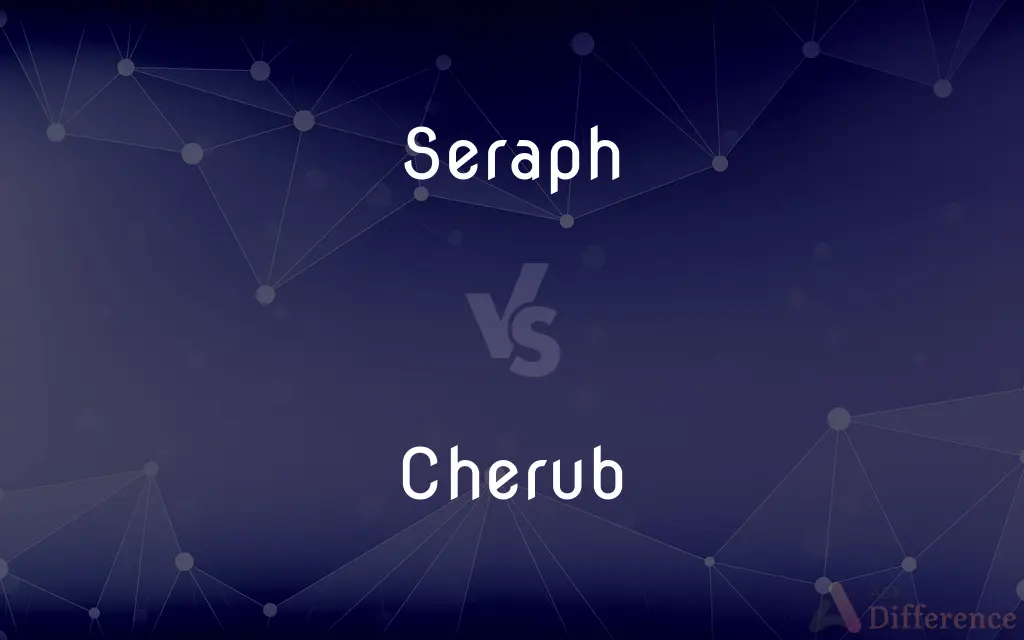Seraph vs. Cherub — What's the Difference?
By Fiza Rafique & Urooj Arif — Updated on May 2, 2024
Seraphim are often depicted as fiery six-winged beings radiating pure light, embodying purification and holiness, whereas cherubim are typically shown with four wings and are known as guardians of sacred spaces.

Difference Between Seraph and Cherub
Table of Contents
ADVERTISEMENT
Key Differences
Seraphim are described in the Bible as celestial beings with six wings, symbolizing their close proximity to God and their role in worship and praise. Whereas cherubim have four wings and are often depicted guarding the way to the Tree of Life and the throne of God.
In theological hierarchy, seraphim rank among the highest order of God's angelic beings, serving as the caretakers of God's throne and continuously singing praises. On the other hand, cherubim hold a slightly lower rank, tasked with guarding divine secrets and sacred realms.
The imagery associated with seraphim is one of light and fire, reflecting their name which means "the burning ones." This is indicative of their role in purifying and sanctifying the faithful. Cherubim, however, are often associated with knowledge and wisdom, symbolically protecting the knowledge of God.
In art and literature, seraphim are portrayed as beings of pure and intense light, often engulfed in flames, symbolizing their divine origin and purity. Cherubim are more commonly represented with a more serene and majestic demeanor, often accompanying God's throne or depicted in Eden.
The roles of seraphim and cherubim in religious texts emphasize different aspects of divine interaction with the world: seraphim as purifiers and worshippers, cherubim as protectors and guardians of holy places.
ADVERTISEMENT
Comparison Chart
Wings
Six wings
Four wings
Symbolism
Purification, holiness, light
Wisdom, guardianship
Biblical Appearance
Isaiah 6:1-7 (throne guardians, sing praises)
Genesis 3:24 (guard Eden), Ezekiel (throne guardians)
Artistic Depiction
Fiery beings, radiant
Serene, majestic, often with child-like faces
Theological Role
Worship and praise near God's throne
Guard sacredness and divine secrets
Compare with Definitions
Seraph
Celestial beings of the highest order, often associated with light and purity.
The artist's depiction of the seraphim conveyed a brilliant, otherworldly light.
Cherub
Guardians of the way to the Tree of Life in Genesis.
The cherubim guarded Eden with a flaming sword, preventing re-entry.
Seraph
Described as having six wings, two covering their face, two covering their feet, and two for flying.
The seraphim in the prophet's vision expressed humility and reverence.
Cherub
Symbolize divine wisdom and authority.
Medieval tapestries showed cherubim bearing swords and scrolls, symbols of wisdom and power.
Seraph
Known for their ceaseless worship of God, chanting "Holy, Holy, Holy."
In the hymn, the choir voices rose in unison, echoing the seraphim’s eternal praise.
Cherub
Featured in visions of Ezekiel and Revelation as part of divine chariot and throne.
Ezekiel’s vision described cherubim underpinning the very structure of God’s throne.
Seraph
Often symbolize God's burning love and judgment.
The preacher described the seraphim as manifestations of divine fervor and judgment.
Cherub
Associated with the protection of God’s glory and presence.
Cherubim statues flanked the ancient temple's entrance, signifying protection.
Seraph
Serve as agents of purification, as seen in Isaiah's vision.
The seraphim purified the prophet with a coal from the altar, symbolizing cleansing.
Cherub
Often depicted as having four wings and sometimes faces of different creatures.
The cherubim carved into the ark had faces that looked in all directions.
Seraph
A seraph (, "the burning one"; plural seraphim ) is a type of celestial or heavenly being originating in Ancient Judaism. The term plays a role in subsequent Judaism, Christianity, and Islam.Tradition places seraphim in the highest rank in Christian angelology and in the fifth rank of ten in the Jewish angelic hierarchy.
Cherub
A cherub (; plural cherubim; Hebrew: כְּרוּב kərūv, pl. כְּרוּבִים kərūvîm, krūvîm, likely borrowed from a derived form of Akkadian: ??? karābu "to bless" such as ??? kāribu "one who blesses", a name for the lamassu) is one of the unearthly beings who directly attend to God, according to Abrahamic religions.
Seraph
(Bible) A celestial being having three pairs of wings.
Cherub
A winged celestial being.
Seraph
Seraphim(Christianity) The first of the nine orders of angels in medieval angelology.
Cherub
Cherubim(Christianity) The second of the nine orders of angels in medieval angelology.
Seraph
(biblical) A six-winged angel; one of the highest choir or order of angels in Christian angelology, ranked above cherubim, and below God. They are the 5th-highest order of angels in Jewish angelology. A detailed description can be found at the beginning of [http://en.wikisource.org/wiki/Bible_%28World_English%29/Isaiah#Chapter_6 Isaiah chapter 6].
Cherub
A putto.
Seraph
One of an order of celestial beings, each having three pairs of wings. In ecclesiastical art and in poetry, a seraph is represented as one of a class of angels.
As full, as perfect, in vile man that mourns,As the rapt seraph that adores and burns.
Cherub
A person, especially a child, with an innocent or chubby face.
Seraph
An angel of the first order; usually portrayed as the winged head of a child
Cherub
(biblical) A winged creature attending God, described by Pseudo-Dionysius the Areopagite (short=yes) as the second highest order of angels, ranked above thrones and below seraphim; similar to a lamassu in the pre-exilic texts of the Hebrew Bible, more humanoid in later texts.
Cherub
An artistic depiction of such a being, typically in the form of a winged child or a child's head with wings but no body.
Cherub
(figuratively) A person, especially a child, seen as being particularly angelic or innocent.
Cherub
A mysterious composite being, the winged footstool and chariot of the Almighty, described in Ezekiel i. and x.
I knew that they were the cherubim.
He rode upon a cherub and did fly.
Cherub
A symbolical winged figure of unknown form used in connection with the mercy seat of the Jewish Ark and Temple.
Cherub
One of a order of angels, variously represented in art. In European painting the cherubim have been shown as blue, to denote knowledge, as distinguished from the seraphim (see Seraph), and in later art the children's heads with wings are generally called cherubs.
Cherub
A beautiful child; - so called because artists have represented cherubs as beautiful children.
Cherub
A sweet innocent baby
Cherub
An angel of the second order whose gift is knowledge; usually portrayed as a winged child
Common Curiosities
Do seraphim have specific roles in religious ceremonies?
While not directly involved in earthly ceremonies, seraphim influence religious thought and art by embodying the ideal of celestial worship and purity.
What does the term "seraphim" mean?
"Seraphim" translates to "the burning ones" in Hebrew, referring to their fiery nature and role in celestial hierarchy.
How do seraphim interact with humans according to scripture?
Seraphim interact with humans by serving as messengers of purification and divine vision, as seen in Isaiah's call to prophecy.
What theological significance do seraphim hold in Christian doctrine?
Seraphim represent the highest level of angelic beings and are considered closest to God, embodying the light of God and serving as a metaphor for divine presence.
What are the physical descriptions of cherubim in religious art?
In art, cherubim are often depicted with multiple wings and sometimes multiple faces, embodying the omnipresence and omniscience of God.
What symbolic roles do cherubim play in biblical texts?
Cherubim symbolize guardianship and protection, particularly of sacred spaces and divine secrets.
In what way do seraphim and cherubim inspire contemporary spiritual practices?
They inspire through their symbolic roles in liturgy and prayer, particularly in the visualization of divine protection and the striving for spiritual purity.
Are there specific prayers or hymns dedicated to seraphim or cherubim in Christian liturgy?
Yes, there are hymns and prayers that invoke the protection of cherubim and the purifying power of seraphim, particularly in Orthodox and Catholic traditions.
Can cherubim be considered angels of mercy in biblical context?
Yes, cherubim can be seen as angels of mercy as they not only guard sacred places but also represent God's mercy in maintaining the order and sanctity of these places.
Are seraphim mentioned in religious texts outside Christianity?
Seraphim are also mentioned in Judaic and Islamic texts, where they hold similarly high ranks and are involved in the worship and praise of God.
What lessons do the roles of seraphim and cherubim teach in spiritual or religious education?
These celestial beings teach lessons about the holiness of God, the importance of worship, the guarding of spiritual truths, and the continuous praise of divine creation.
How do depictions of seraphim and cherubim vary across different Christian denominations?
Depictions vary significantly; Orthodox Christianity often portrays them in a more traditional and symbolic manner, while Western Christianity may incorporate more abstract or humanized interpretations in art and literature.
How are cherubim depicted differently in Western art compared to Eastern traditions?
In Western art, cherubim are often depicted as small, chubby infants with wings; in Eastern Christian iconography, they are more likely to appear as majestic, winged creatures.
How does the number of wings affect the roles of seraphim and cherubim?
The number of wings is symbolic of their capacities and duties; seraphim's six wings signify their supreme role in worship and purity, while cherubim's four wings align with their role as guardians.
What is the difference between cherubim in the Bible and cherubs in popular culture?
Biblical cherubim are powerful and majestic creatures, while popular culture often reduces cherubs to the role of cute, infant-like figures in art and literature.
Share Your Discovery

Previous Comparison
Inner vs. Internal
Next Comparison
Cougar vs. PumaAuthor Spotlight
Written by
Fiza RafiqueFiza Rafique is a skilled content writer at AskDifference.com, where she meticulously refines and enhances written pieces. Drawing from her vast editorial expertise, Fiza ensures clarity, accuracy, and precision in every article. Passionate about language, she continually seeks to elevate the quality of content for readers worldwide.
Co-written by
Urooj ArifUrooj is a skilled content writer at Ask Difference, known for her exceptional ability to simplify complex topics into engaging and informative content. With a passion for research and a flair for clear, concise writing, she consistently delivers articles that resonate with our diverse audience.
















































